Slow but steady progress is just that, not a “stalemate,” and the dynamics still overwhelmingly favor Ukraine
(Russian/Русский перевод; Если вы состоите в российской армии и хотите сдаться Украине, звоните по этим номерам: +38 066 580 34 98 или +38 093 119 29 84; инструкции по сдаче здесь)
By Brian E. Frydenborg (Twitter @bfry1981, Threads @bfchugginalong, LinkedIn, Facebook, Substack with exclusive informal content) September 30, 2023; because of YOU, Real Context News surpassed one million content views on January 1, 2023, but I still need your help, please keep sharing my work and consider also donating! Real Context News produces commissioned content for clients upon request at its discretion. Also, Brian is running for U.S. Senate for Maryland and you can learn about his campaign here.
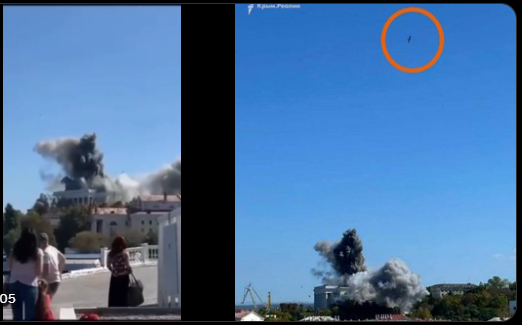
AN IMPORTANT NOTE TO MY READERS: Dear readers, I know it’s been a while since a Ukraine update and I apologize, I have just had a lot of personal and professional issues that needed to take priority, plus I am trying to move ahead with my U.S. Senate campaign here in Maryland. And I will be honest: it’s been really tough recently for me. Not least of the reasons for this are that backup Bond villain Elon Musk continues to ruin Twitter based on absolutely false pretenses, to boost content he personally favors (which sure is not mine) and that is often disinformation or hate speech and to deboost content like mine along with content about Ukraine (I keep getting Russian government accounts, Tulsi Gabbard, and Republican Party accounts that I do not follow in my feed and it was recently suggested by Twitter that I follow Iran’s Ayatollah Khamenei, of all people; THIS is Elon Musk’s Twitter). But there is still nothing else anywhere approaching Twitter’s reach or power, Threads isn’t even close to functioning like Twitter does if you are a journalist sharing your content. So fewer and fewer people are being exposed to my work because of Elon’s deliberate biased changes to Twitter and its algorithms. That means fewer shares and fewer donations, far, far fewer, I am sad to report. That’s why it’s more important now than ever that you, my dear readers, new and old, continue to support my efforts here at Real Context News by continuing to read, share, and donate. Your traffic, shares, and donations however small make a huge difference for me and my ability to keep up my unique work here. It is because of you that I am able to do this, this site and this content does not exist without you so please keep up or begin your generous support as I struggle through these difficult times. In particular, if you are a notable person in the relevant fields and/or have a large following here, plugging my work, not just retweeting but plugging it, can have a HUGE impact on the reach of any of my particular articles, and the more reach the more donations I receive. This is not at all in doubt as I see the dramatic results in traffic and donations when you do. But, again, even the smallest donations are helping me a lot and lots of shares with even a small reach from a lot of different people have a cumulative effect, so no matter who you are, please do consider sharing, donating, and encouraging others to do the same, it means the world to me and really does make a difference. I dedicate this article to you and the Ukrainian people.
SILVER SPRING—The Oxford Advanced Learner’s Dictionary defines a stalemate primarily as “a disagreement or a situation in a competition in which neither side is able to win or make any progress.” In case any of my readers are some of the people producing headline after headline, article after article proclaiming a “stalemate” in Ukraine to Kyiv’s forces’ detriment, let me emphasize that the definition is one of “neither side…being able to make any progress,” emphasis mine. Let’s be more generous and consider the idea to be of a net-quality: if both sides make minimal but equal progress—say, just two square miles of progress in two weeks made by each side on different points in their line, both sets of two square miles being of roughly equal strategic value—we can say that that is a net gain of zero—each side won and lost two comparable square miles (not all territory is equal)—and that that, too, is in spirit a stalemate. So by that definition, it’s not that neither side is not making any progress, but that neither side is having a net gain over its opponent.
Yet even under this less restrictive definition, anyone at all who employs the term “stalemate” to apply to the overall war in Ukraine between the Ukrainian and Russian sides is being recklessly ridiculous and simply furthering a false Kremlin narrative.
In the past few months, the counteroffensive is gaining steam and momentum is clearly on Ukraine’s side.
Ukraine Advancing in Bakhmut and Zaporizhzhia
This progress has mainly come in two geographic areas.
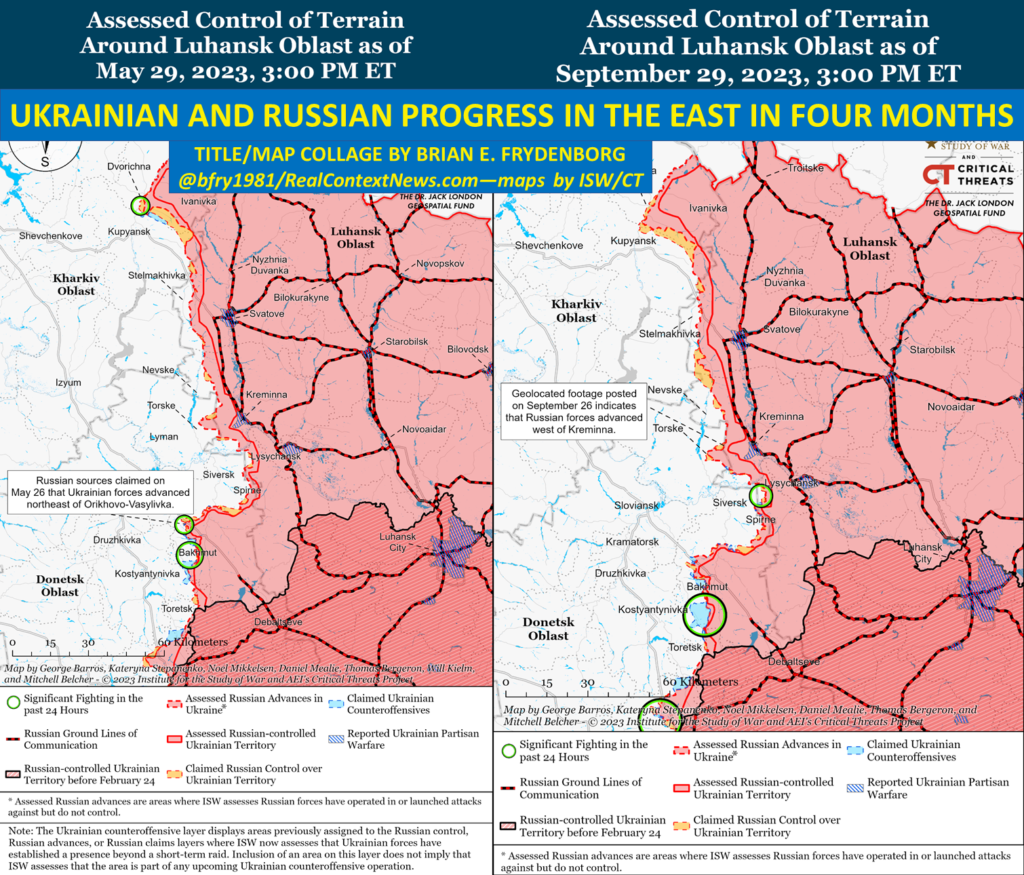
First to discuss are months of Ukrainian counterattacks taking territory north and south of Bakhmut, which Russian forces spent close to a year taking and saw tens of thousands killed in the process in the very definition of a Pyrrhic victory, mostly from the efforts of the now-murdered, onetime-rebel-against-the-Kremlin Yevgeniy Prigozhin’s Wagner Group forces, whose remnants are being so mistreated now by the Kremlin that the risk of rebellion from them is hardly over. And as I noted before Russia had even fully taken Bakhmut, Russia’s near-pointless offensive there even if it took the city would only setup what we are seeing now: a successful Ukrainian counterattack that would take territory far faster than Russia had. Ukraine’s advances there are setting up a possible encirclement of Russian forces in Bakhmut should they continue to advance both north and south of the city. And all during Ukraine’s retaking territory north and south of the city, Russia has continued in conducting attacks that have failed to take and hold territory but have certainly resulted in high Russian casualties. Bakhmut, itself a small city that lacks even moderate strategic significance, was by far the largest “victory” Russia could claim since the first few months of the war that is now over a year-and-a-half old; should Russia lose control of it after suffering such Pyrrhic losses in taking it, the embarrassment for Russia’s fascist President Vladimir Putin and the Kremlin leadership would be extreme, hollowing out further any claims they can make to their people that they are “winning” in Ukraine of that things are “going according to plan” and making only more obvious Putin’s clear weakness. In fact, Ukrainian advances here and elsewhere have meant Russia has had to divert forces from its own nearby paltry and ineffective offensive in the Kreminna-Kupyansk front to the point where it may be petering out after accomplishing very little, taking some territory but mostly in unpopulated woods in an area even less strategically significant on the eastern front than Bakhmut. Admittedly, even Bakhmut’s “importance” is in part because has Russia forced so much attention on Bakhmut, making it a prize more valuable because of its propaganda value and the embarrassment it would cause Russia should Russia lose it, but at least it is a crossroads city and not just empty forest. Thus, Russia’s gains in Kreminna Forest are not equivalent to any similar gains near the symbolically important city of Bakhmut or in the far more strategically important Zaporizhzhia theater.
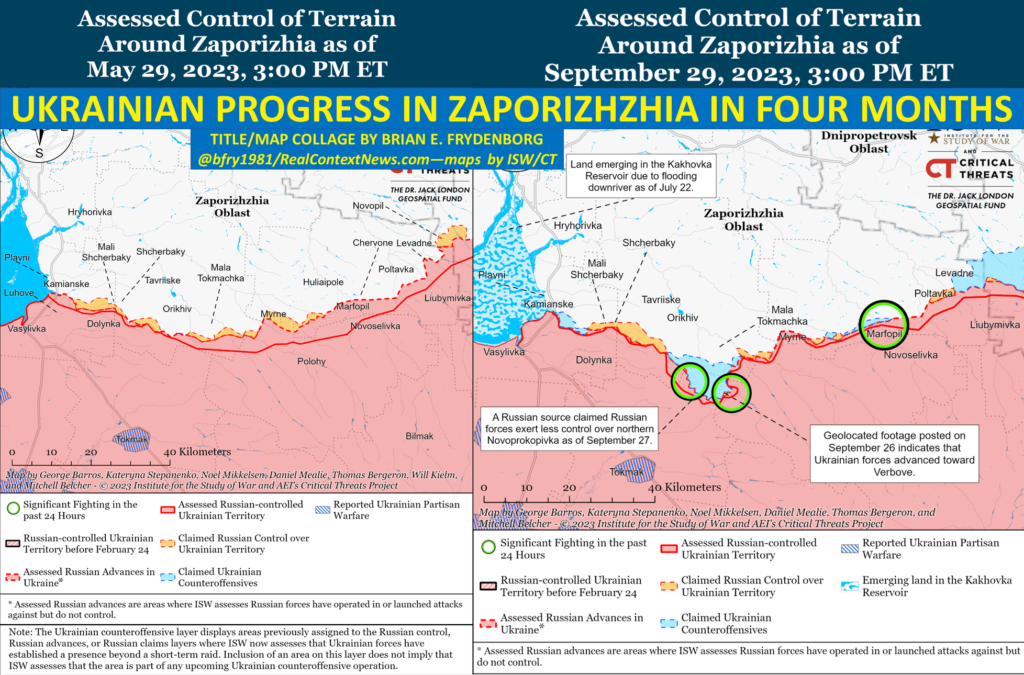
But there is also arguably an even larger thrust and more strategically significant gains for Ukraine in Zaporizhzhia Oblast, particularly in driving towards the critical Russian logistics hub at Tokmak and penetrating Russian lines of defense towards this end. Even if a there are not signs of an imminent breakthrough—such a major penetration that a significant section of the main defense line collapses—Ukraine’s progress has been steady and enough such progress should eventually lead to a breakthrough. A breakthrough in these lines could bring Ukraine to the outskirts of Tokmak, the last main hub before the major city of Melitopol, the fall of which would cut Russia’s land bridge to Kherson and Crimea and severely degrade Russian logistics for much of its holdings in Ukraine. Ukraine is currently less than thirty kilometers from Tokmak—where Russia’s air defenses comically managed to just shoot down one of its own Su-35 fighter jets—though the territory in between is heavily defended. That should come as no surprise as Russia has had a long time to prepare fortifications there and, worse yet, minefields: Russia’s mine-laying efforts have made this terrain some of the most heavily mined in the world, with as many as five mines per square meter, thus, the progress has to at first be painstakingly slow in order to clear the mines and minimize Ukrainian casualties, explaining much of why this counteroffensive is moving far slower than some of Ukraine’s previous, more spectacular ones (this intense level of fortification is the case further behind the front lines in the east, too).
Still, this does not mean Ukraine is “losing” or not making progress, and this means a limited number of Russian positions are all that stand in the way, even if heavily defended, and, as Ukraine has demonstrated the ability to maintain steady if slow progress in penetrating these positions, there is reason to believe that Tokmak is very possible as an objective, then Melitopol after that. And it seems Russia has little defense in depth and few reserves in the area: the same Russian units that are manning the forward lines are also manning the lines behind those and positions down to Tokmak, thus, these forces are spread thinly and are taking serious losses and retreating even as I write this. The only Russian troops available to reinforce would very likely have to come from other sections of the line, weakening those sections, or would be green raw recruits. What is not happening is Russia counterattacking successfully and pushing Ukraine back here (or near Bakhmut): to expect anything else would be to expect a reversal of the overall dynamics in place since the second week of April in 2022. Those dynamics—including Russian losses that are far, far higher than Ukraine’s—may be lessened or wax and wane, but they are still present, are hardly close to reversing, and overwhelmingly favor Ukraine, as I have noted for quite some time. So, while progress has been slow so far, Ukraine is gaining momentum on this key Tokmak-Melitopol axis. Indeed, unlike Russia—which has demonstrated a sickening callousness towards its own troops—Ukraine has in the past been content to go slow and careful when it sees fit to minimize casualties (Ukrainian prudence meeting Russian limitations, as I noted here, and in that case it led to the major breakthroughs of last summer and early fall). This current counteroffensive has thus far been another of those instances or Ukrainian prudence over Russian recklessness.
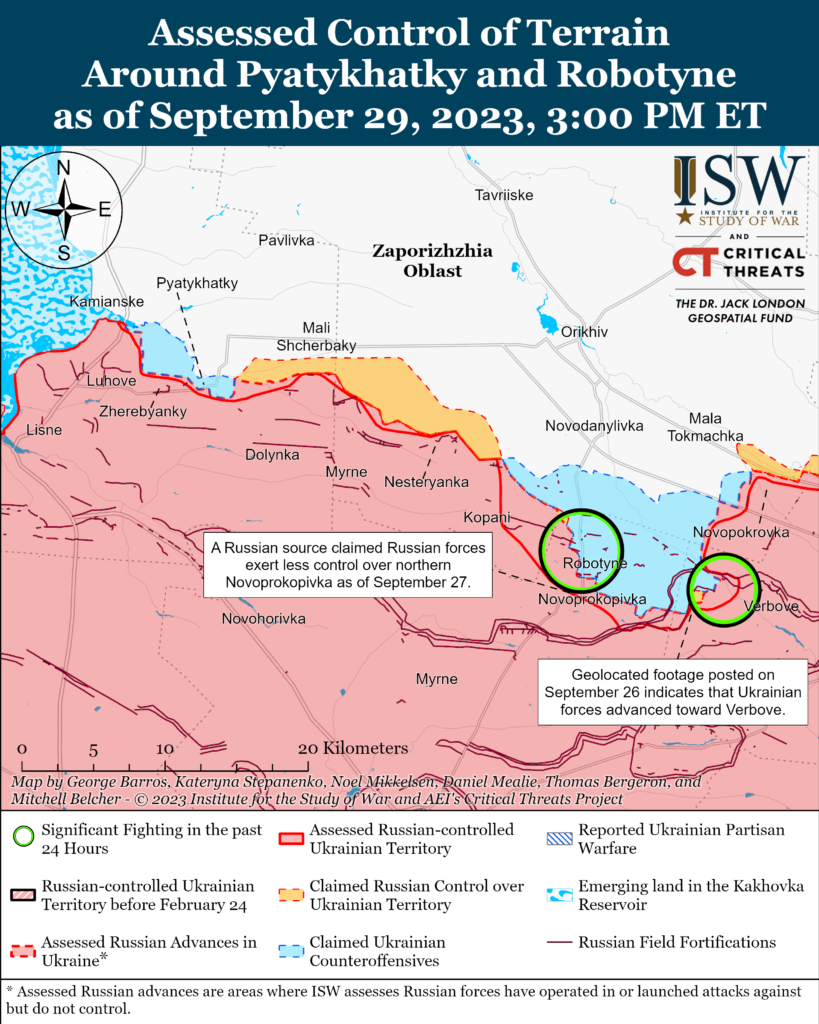
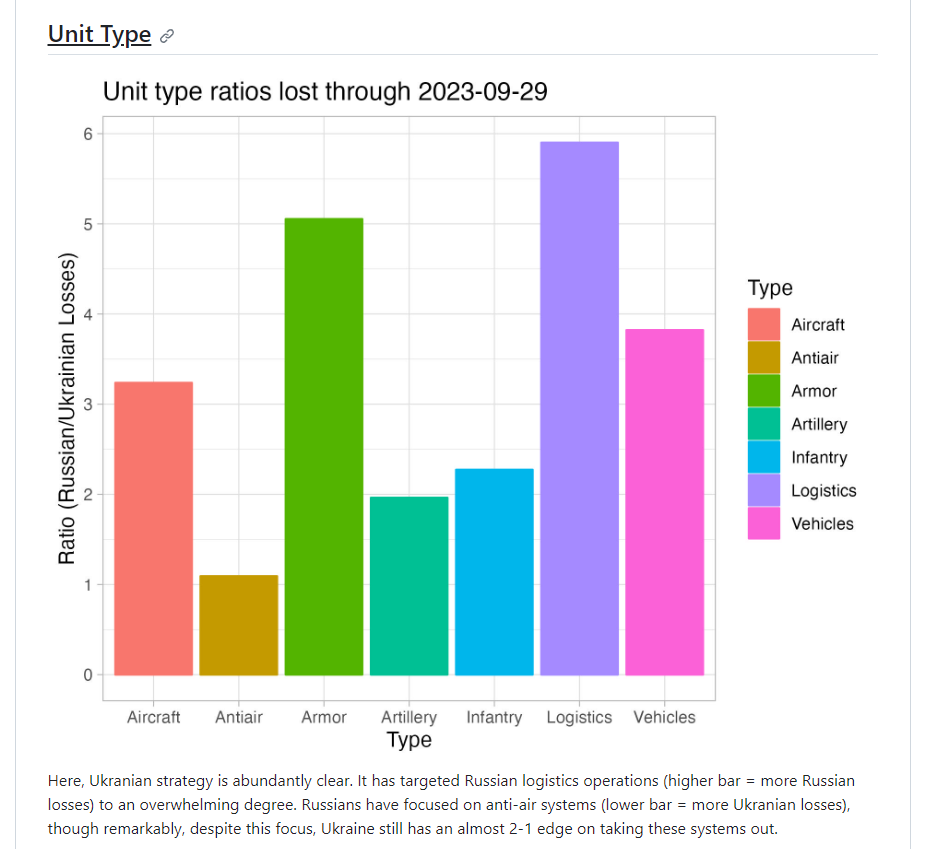
In both Zaporizhzhia and near Bakhmut, Ukraine keeps gaining, Russia keeps losing, with some Russian insiders knowing this and are publicly admitting their side is losing.
Other Dynamics Also Clearly Favor Ukraine
That would be enough to tell you that Ukraine is winning. But there are other reasons that this is the case.
There are important reasons to believe that Ukraine is winning the war of attrition here, which will make a breakthrough more and more likely. After all, not only is Russia running low on experienced military officers to lead its formations at the tactical level from both casualties and the demoralized leaving the military, Russia is apparently running low on its better better-quality troops, particularly its (relatively) elite VDV Airborne troops,, roughly half of the some 30,000 of whom were deployed in 2022 apparently becoming casualties by early August of this year. Ukraine has been weakening defenses in key parts of the Russian line in western Zaporizhzhia Oblast, and in response, Russia is moving some of those key VDV Airborne troops from the Kherson front in the south and the Kreminna and Bakhmut fronts in the east, leaving those locations even more vulnerable. If things were going well in Zaporizhzhia, Russia would not be pulling these elite troops (available in limited quantities and nearly impossible to replace given the collapse the collapse of Russia’s training regime as Russian cannibalizes its limited trainers to by deploying them to Ukraine) to face the most intense attacks of the Ukrainian military. If the Russian Airborne VDV troops take enough casualties and we should expect they will, that could demoralize the other troops along the line. And as with other Russian troops, these VDV, too, are still being poorly led and supported, taking careless casualties. In fact, overall, Russian forces are being run into the ground, even being denied leave after a year of service (lies from the Russian government promised them two months’ leave every six months). As any good commander will tell you, failing to rest, refit, and rotate troops is a recipe for an eventual collapse in combat effectiveness and chronic underperformance.
And on top of this, Ukraine has just received the promised Abrahms tanks from the Biden Administration as it continues its historic support of Ukraine’s war effort of a scale not seen by any nation since U.S. support for the U.K., Soviet Union, and others through Lend-Lease in World War II (the only other comparable effort in history). Ukraine will also be receiving the long-range ATACMS missile it has so intensely requested for months. The Abrahms tanks could add some significant punch to Ukraine’s attacks wherever it decides to deploy them, and the ATACMS will threaten key Russian command and control, air defenses, logistics and supplies, and infrastructure in the rear, harming Russia’s ability to support their troops on the front line and also exposing troops it is redeploying to fire at an even longer distance from the front line. Ukraine is even using cheap modern drones to knock out Soviet-made guns that are almost eighty-year-old models (the D-44 which was first deployed in 1946) while Russia may also be running low on artillery gun replacement barrels that are wearing out from overuse and being of inferior quality (thanks to Trent Telenko for bringing that to my attention); considering the primacy of artillery in Russian military doctrine, the potential for this to be a major factor going forward if Russia is not able to remedy it could be severe for the Russian military, especially since there are signs Ukraine is already winning the artillery war.
Ukraine has also demonstrated that it can strike anywhere in Crimea—meaning nowhere on the peninsula is safe for the Russian occupiers—and that the Russian Black Sea Fleet’s main vessels are no longer safe in its headquarters port of Sevastopol in Crimea—not even a Kilo-class cruise missile-carrying submarine in a drydock, meaning Ukraine has destroyed one of just five Black Sea Fleet submarines—nor are the Black Sea Fleet’s top brass in its now blown-up main headquarters building, blown up in a Ukrainian cruise missile strike that killed dozens of senior officers, perhaps including the actual commander of the Black Sea Fleet, Admiral Viktor Sokolov (or perhaps not him but still many other senior officers…). Even Russian insiders are admitting such attacks expose Russia’s weakness, and, as I noted would happen long ago, the Russian Navy is becoming largely irrelevant. Crimea itself could in the not-too-distant future even become a liability for Russia to occupy.
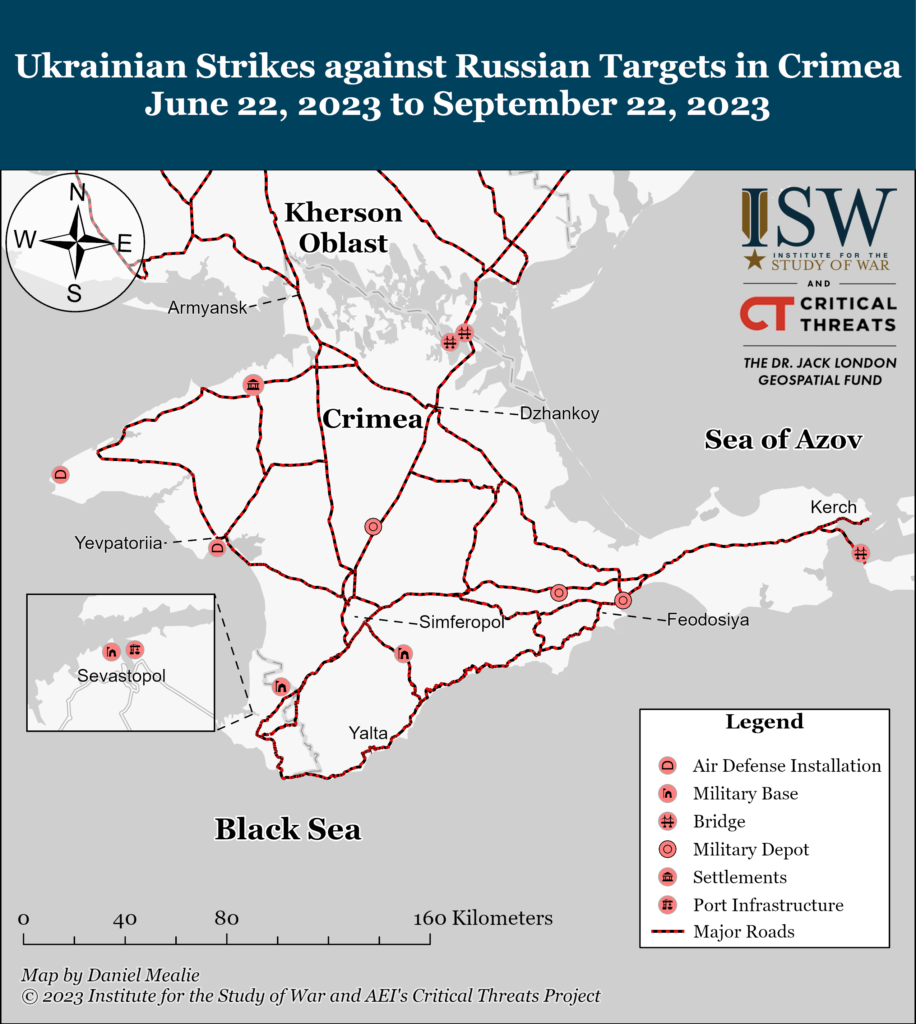
Ukraine has also been using drones to consistently strike targets inside Russia, including destroying bomber aircraft at bases deep inside Russia and hitting oil facilities along with Moscow itself. And oh, the Freedom of Russia Legion (or Freedom/Liberty of Russia Legion), a group of Russian rebels who want to overthrow Putin and are supported by Ukraine, is again raiding in southwestern Russia, forcing Russia to throw troops and air defenses into defending its own actually Russian territory, forces that are therefore not being deployed where they are needed in Ukraine. As I have noted repeatedly, Ukraine’s capabilities keep increasing while Russia’s keep decreasing.
Also, be sure to keep an eye on Kherson, another area where Ukraine has opted for caution but where it has had a presence on the bank of the Dnipro River south and east of Kherson City for months, where Russian forces’ morale is low from mistreatment by commanders, where Russian positions seem to be experiencing supply issues and are relatively weak, especially after, as noted, Russia has redeployed more experienced troops like the elite Airborne VDV troops from there to Zaporizhzhia. Additionally, after (almost certainly) Russia destroyed the Nova Kakhokova Dam, Russia has removed the reservoir there as a barrier separating Ukraine from the other side of the Dnipro Rover there. Yes, in one of the stupidest and most backfiring war crimes in history, the drained reservoir is now another land route that can be invaded and crossed by Ukrainian forces, perhaps even by heavy vehicles. In short, there is a very real possibility of a major thrust by Ukrainian into the Russian-occupied parts of Kherson, which would both threaten to flank Russian positions in western Zaporizhzhia, already under intense pressure and where Russians are losing and retreating, and puts Ukrainian forces in a position to seal off and threaten Crimea, beginning what I anticipate would be the Siege of Crimea (I discussed in detail how that could unfold here). And, as is the case for Russia before, it can move troops to meet such a potential threat and weaken its defenses in other key sectors or leave itself even more unprepared in Kherson, making such at attack even more likely: Russia has no good options, as I have argued before. Considering all this, southern Kherson now calls as an even more attractive target, with any major successful thrust by Ukraine further into that region putting incredible pressure on both Crimea and the Russian-occupied parts of Zaporizhzhia. Such a successful campaign would essentially be the beginning of the end of Russia’s war in Ukrainian territory and its unwanted presence in Ukraine that began in 2014. If there is going to be a surprise and/or more rapid breakthrough for Ukraine the likes of which we have seen before, the Kherson front is as good a possibility for this as any.
Finally, Russia has gained no serious diplomatic support since the beginning of Ukraine’s counteroffensive, but Ukraine has, as its allies beyond the U.S. continue to send major aid packages Kyiv’s way. Conversely, the traditional clients of Russia’s in Central Asia—the former Soviet republics of Kazakhstan, Turkmenistan, Uzbekistan, Tajikistan, and Kyrgyzstan—recently announced they are going to cooperate more with the West in several areas, including on implementing sanctions, with even Kazakhstan—where Russia sent its military at the government’s request as recently as January 2022 to help that country put down major protests—explicitly saying it will cooperate on sanctions against Russia. As this is going on, Russia’s traditional client of the former Soviet republic of Armenia has seen Russia lose credibility as a patron as it has been powerless to and/or unwilling to stop Azerbaijan’s dramatic recent takeover of Armenian enclave Nagorno-Karabakh—even attacking Russian “peacekeepers” in the process—and resulting in a humanitarian disaster with over half its population thus far becoming refugees. Understandably, Armenia is turning away from Russia and perhaps towards the West, further weakening Russia’s stature internationally at a time when it is already incredibly isolated. Also quite pathetically, Putin is begging North Korea’s Kim Jong Un for artillery shells (North Korea was founded largely on Soviet aid and was a client state of the Soviet Union for decades, speaking to how low Russia has sunk today). How to Lose Nations and Alienate People, by Vladimir Putin, indeed.
Conclusion: Ukraine Still Winning, Russia Still Losing, Nowhere Near a Stalemate
Thus, to all those complaining that the Ukrainian counteroffensive is “taking too long” and screeching that Ukraine should, as a result, negotiate away a huge portion of its sovereign territory in a way guaranteed to not bring any stability or peace to Ukraine over the long run, I say that the longer this counteroffensive continues, the better off Ukrainian forces will be and the worse off Russian forces will be, the more of its own territory Ukraine will liberate and the less Ukrainian territory Russia will illegally occupy, the weaker Putin will be at home and the greater the chance for Russia to have a future without his fascist warmongering tyranny.
And, contrary to a new round of preemptive bad takes that the coming winter is somehow going to mean the Ukrainian counteroffensive will be unable to continue during it, the winter, again and as I noted last winter, will be much worse for Russian forces than it will be for Ukrainian forces.
In the end, it is not difficult to tell who is winning and who is losing. Those proclaiming stalemate are not only abusing the English language (or whatever language they are writing in), they are maligning and negating the very real gains made by Ukrainian forces—net gains—against some of the most heavily mined and most heavily fortified territory currently on the planet, coming at far from no cost but in willing sacrifices in life and limb as Ukrainians prove time and time again they are willing to fight for their land, for their homes, for each other, for their freedom, for democracy to triumph over fascist kleptocratic autocracy in Ukraine and Europe overall. So enough with the “expert” analysis characterizing the current state of the war as a “stalemate,” as Ukraine is clearly still winning and Russia is clearly still losing, even if less clearly than in other more spectacular phases of the conflict.
Brian’s Ukraine analysis has been praised by: Mykhailo Podolyak, a top advisor to Ukrainian President Volodymyr Zelensky; the Ukraine Territorial Defense Forces; Lt. Gen. Ben Hodges, U.S. Army (Ret.), former commanding general, U.S. Army Europe; Scott Shane, two-time Pulitzer Prize-winning journalist formerly of The New York Times & Baltimore Sun (and featured in HBO’s The Wire, playing himself); Rep. Adam Kinzinger (R-IL), one of the only Republicans to stand up to Trump and member of the January 6th Committee; and Orwell Prize-winning journalist Jenni Russell, among others.
See all Brian’s Ukraine coverage here
© 2023 Brian E. Frydenborg all rights reserved, permission required for republication, attributed quotations welcome
Also see Brian’s eBook, A Song of Gas and Politics: How Ukraine Is at the Center of Trump-Russia, or, Ukrainegate: A “New” Phase in the Trump-Russia Saga Made from Recycled Materials, available for Amazon Kindle and Barnes & Noble Nook (preview here).
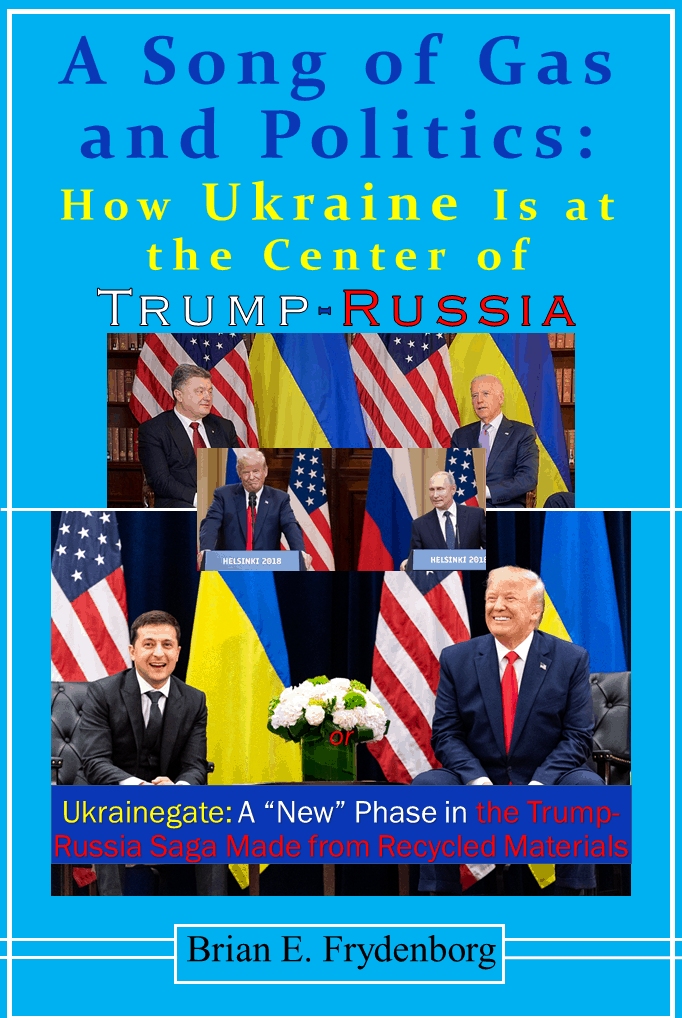
If you appreciate Brian’s unique content, you can support him and his work by donating here; because of YOU, Real Context News surpassed one million content views on January 1, 2023. Real Context News produces commissioned content for clients upon request at its discretion.
Feel free to share and repost this article on LinkedIn, Facebook, Threads, and Twitter. If you think your site or another would be a good place for this or would like to have Brian generate content